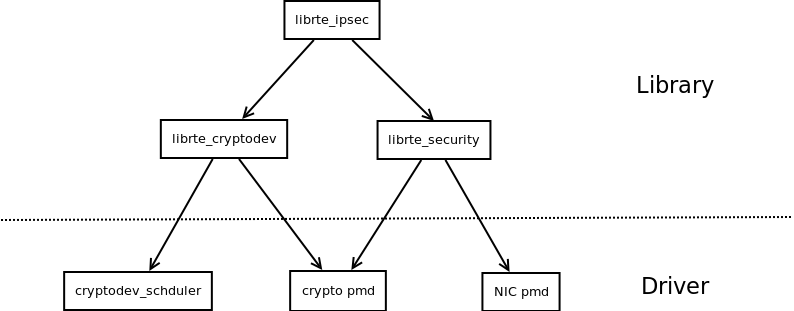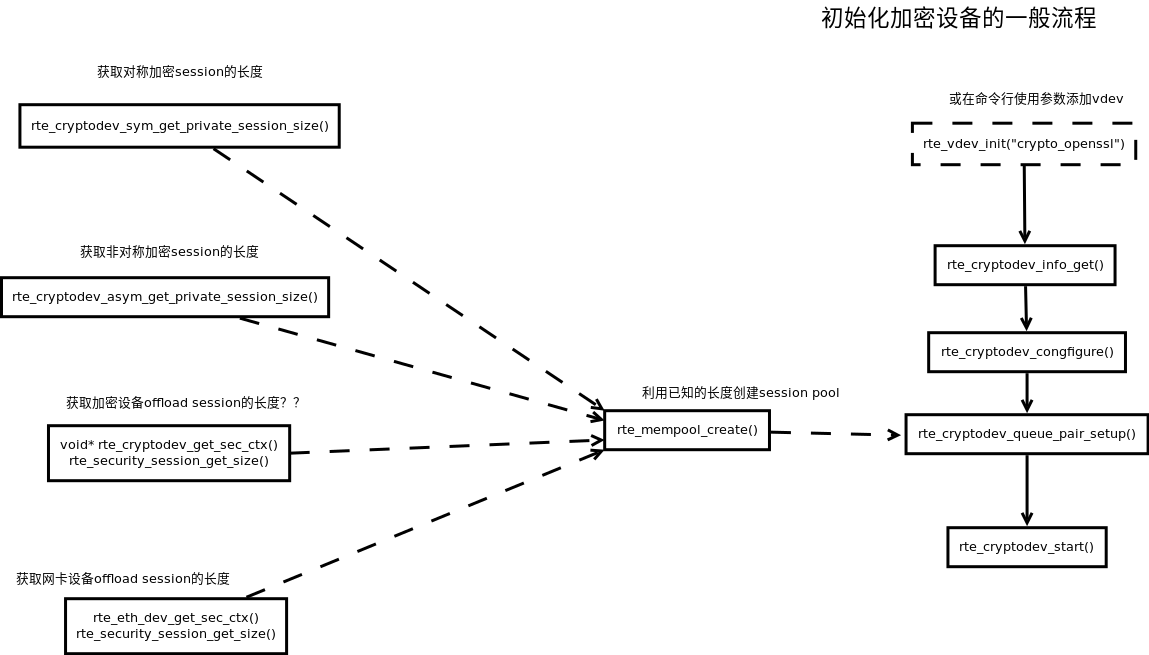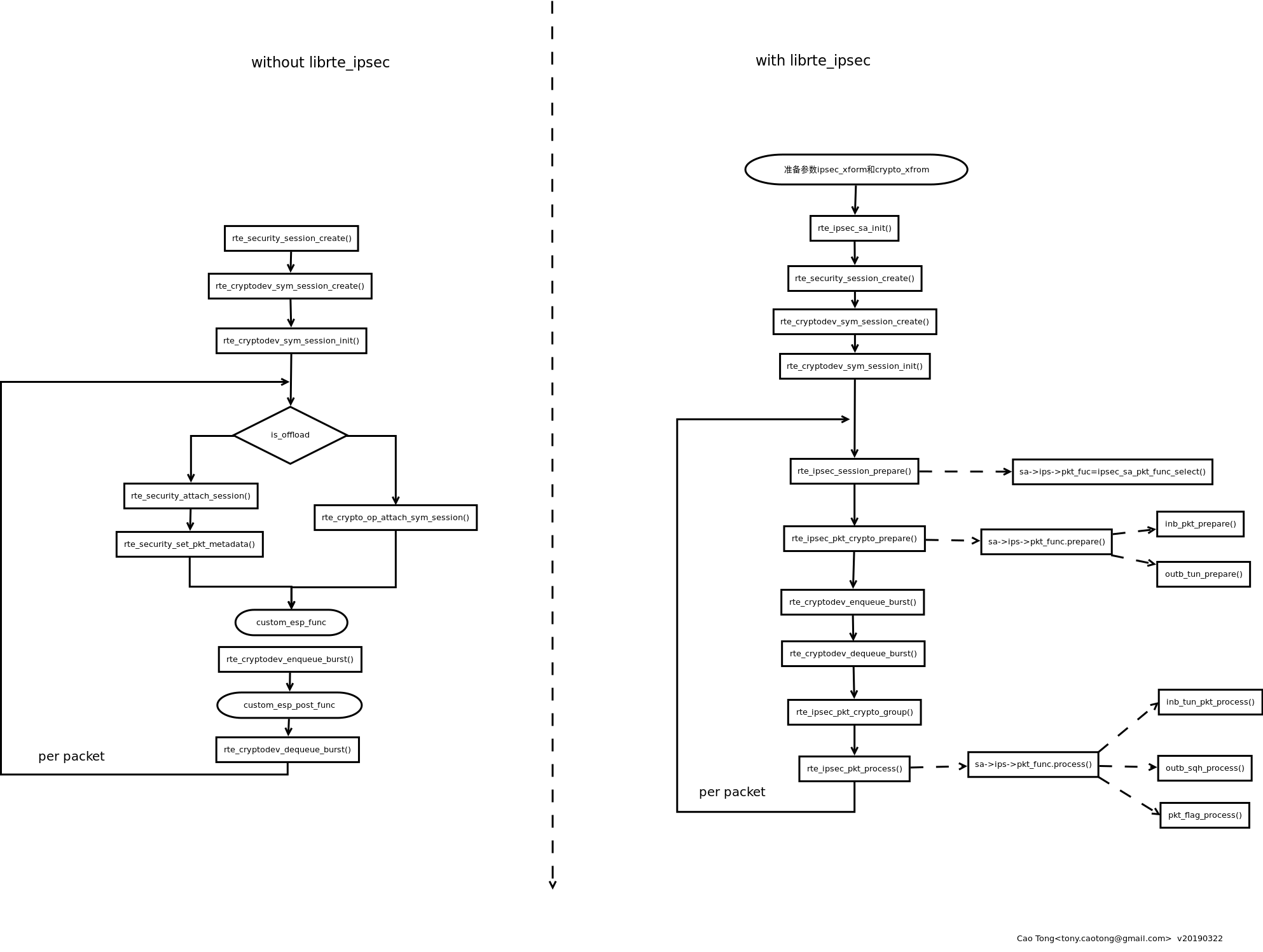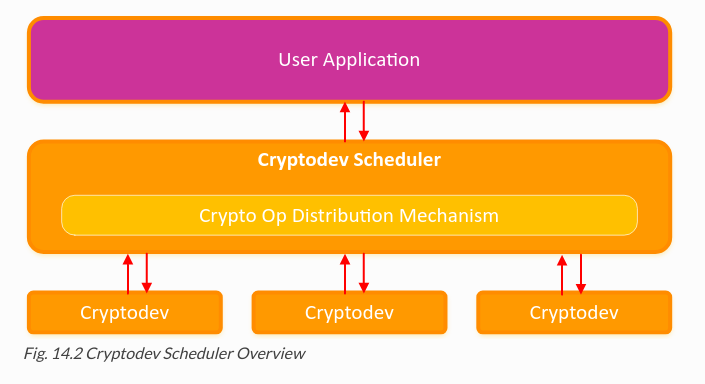概述
分三部分,加解密框架(crypto framework),加解密设备(crypto dev),安全协议(Security Framework)
× API,设计思路等,都在加解密框架里:见文档:http://doc.dpdk.org/guides-18.11/prog_guide/cryptodev_lib.html
× 设备层的事情,加解密设备的分类,调度,主备等,见文档:http://doc.dpdk.org/guides-18.11/cryptodevs/index.html
× ESP,PDCP等网络加密协议相关的事情,主要功能是整合NIC pmd和Crypto pmd,见文档:http://doc.dpdk.org/guides-18.11/prog_guide/rte_security.html
另外还有一个追加的部分,ipsec (rte_ipsec)
* 这一部分主要是对前面三个部分的整合封装调用,用来专门处理ipsec报文。见文档:http://doc.dpdk.org/guides/prog_guide/ipsec_lib.html
画个图:

如果,以上三个文档,你都读完了,那么请不要再往下读了。内容重复。且本人懒惰,多以摘要为主,写的也不好 :)
一般编程模型
画了一张图,还没完全整理好,后续有可能会再更新,也有可能不更新了。
是参考dpdk的这个例子里的流程画的:http://doc.dpdk.org/guides/sample_app_ug/ipsec_secgw.html
初始化加密设备的一般流程。

设备就绪后的一般使用流程。(需要关注的是:在分析rte_ipsec的源码过程中,并没有发现对API rte_crypto_op_attach_sym_session的调用。奇怪。。。)

// TODO init dpdk crypto things. // 1. init sa->xforms like function sa_add_rules() // 2. init two parameter ipsec_xform/crypto_xform // 2. ipsec_sa_init() // 2.1 rte_ipsec_sa_init() // 3. create_session // 3.1 rte_security_session_create() // 3.2 rte_cryptodev_sym_session_create() // 3.3 rte_cryptodev_sym_session_init() // 3.4 rte_ipsec_session_prepare() // 3.4.1 sa->ips->pkt_func = ipsec_sa_pkt_func_select() // 3.5 rte_ipsec_pkt_process() // 3.5.1 sa->ips->pkt_func.process() // 3.6 rte_ipsec_pkt_crypto_prepare() // 3.6.1 sa->ips->pkt_func.prepare() // 7 rte_cryptodev_enqueue_burst() // 8.rte_cryptodev_dequeue_burst() // 9 rte_ipsec_pkt_crypto_group() // 10 rte_ipsec_pkt_process() // 3.5.1 sa->ips->pkt_func.process() // outbound // 4 rte_security_attach_session() // 5 rte_crypto_op_attach_sym_session() // 6 rte_security_set_pkt_metadata() // 7.rte_cryptodev_enqueue_burst() // 8 rte_cryptodev_dequeue_burst()
第二部分,设备(crypto dev)
所有的加解密设备大概分为以下几种:openssl,null,硬件架构相关的设备。
null为纯软件的最小实现,可以用来调试等。
硬件相关的主要包括,Intel,arm,NXP,AMD,QAT卡等。
还有一种,基于VIRTIO的PMD设备。
不同的设备,所支持的加解密算法也各有不同,有一个详细的对比列表,见:
http://doc.dpdk.org/guides-18.11/cryptodevs/overview.html
设备调度
在各设备的上层,还有一个调度设备,用于管理和协调多个加解密设备直接的数据流。叫做 cryptodev scheduler PMD
http://doc.dpdk.org/guides-18.11/cryptodevs/scheduler.html

接口API
加解密设备的调度API(schduler)
http://doc.dpdk.org/api-18.11/rte__cryptodev__scheduler_8h.html
加解密设备的使用API (cryptodev)
http://doc.dpdk.org/api-18.11/rte__cryptodev_8h.html
第一部分 框架(crypto framework)
架构设计文档:http://doc.dpdk.org/guides-18.11/prog_guide/cryptodev_lib.html
设计理念
The cryptodev library follows the same basic principles as those used in DPDKs Ethernet Device framework.
The Crypto framework provides a generic Crypto device framework which supports both physical (hardware)
and virtual (software) Crypto devices as well as a generic Crypto API which allows Crypto devices to be
managed and configured and supports Crypto operations to be provisioned on Crypto poll mode driver.
设备初始化方法
A。 初始化设备
实体设备:与PCI网卡相同。
虚拟设备:1. 可以使用 --vdev参数在dpdk程序启动时使用。2. 在运行时使用api:
rte_vdev_init("crypto_aesni_mb", "max_nb_queue_pairs=2,socket_id=0")
B。配置设备
设备识别:用Id或name
设备配置:使用api:
int rte_cryptodev_configure(uint8_t dev_id, struct rte_cryptodev_config *config) struct rte_cryptodev_config { int socket_id; /**< Socket to allocate resources on */ uint16_t nb_queue_pairs; /**< Number of queue pairs to configure on device */ };
C。配置queue








 本文深入探讨DPDK的加解密框架、设备及安全协议,重点介绍了加密设备类型、调度机制、API接口,以及RTE_IPSEC库在处理IPSEC报文中的作用。涉及内容包括设备初始化、硬件offload、安全会话和API接口等。
本文深入探讨DPDK的加解密框架、设备及安全协议,重点介绍了加密设备类型、调度机制、API接口,以及RTE_IPSEC库在处理IPSEC报文中的作用。涉及内容包括设备初始化、硬件offload、安全会话和API接口等。
 最低0.47元/天 解锁文章
最低0.47元/天 解锁文章
















 1195
1195

 被折叠的 条评论
为什么被折叠?
被折叠的 条评论
为什么被折叠?








